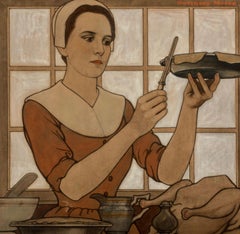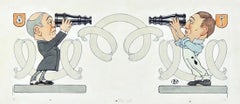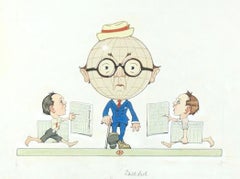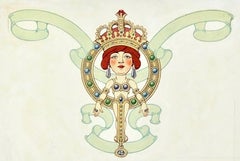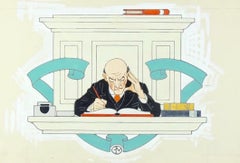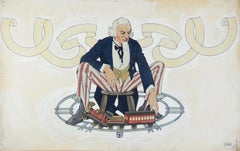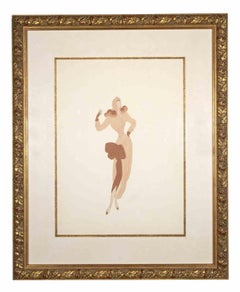Guernsey Moore Figurative Drawings and Watercolors
to
16
4
1
Overall Width
to
Overall Height
to
21
1
4
12
14
6
1
21
16
12
11
9
7
3
3
2
2
1
1
1
1
1
1
1
1
1
1
20
1
1
1
1
23
888
324
192
178
11
21
Artist: Guernsey Moore
Thanksgiving, The Saturday Evening Post Cover, November 1905
By Guernsey Moore
Located in Fort Washington, PA
Medium: Watercolor and Ink on Board
Signature: Signed Upper Right
Dimensions: Sight Size 16.00" x 16.50;" Framed 24.50" x 25.00"
The Saturday Evening Post...
Category
Early 1900s Guernsey Moore Figurative Drawings and Watercolors
Materials
Ink, Watercolor, Board
"Whereas, the Women, " Story Illustration, Saturday Evening Post, 1922
By Guernsey Moore
Located in Fort Washington, PA
"Whereas, the Women," by George Kibbe Turner, illustrated by Guernsey Moore for the Saturday Evening Post, July 22, 1922.
Category
1920s Guernsey Moore Figurative Drawings and Watercolors
Materials
Paint
"The Rewards of Journalism" Story Illustration in the Saturday Evening Post
By Guernsey Moore
Located in Fort Washington, PA
"The Rewards of Journalism," by Chester S. Lord and illustrated by Guernsey Moore for the Saturday Evening Post, September 9th, 1922.
Category
1920s Guernsey Moore Figurative Drawings and Watercolors
Materials
Paint
"More Precious than Rubies, " Story Illustration for Saturday Evening Post, 1924
By Guernsey Moore
Located in Fort Washington, PA
Signature: Unsigned
"More Precious than Rubies," by Katherine Sproehnle and Jane Grant, illustrated by Guernsey Moore for the Saturday Evening Post, June 7, 1924.
Category
1920s Guernsey Moore Figurative Drawings and Watercolors
Materials
Paint
"Writing for Print" Story Illustration for the Saturday Evening Post
By Guernsey Moore
Located in Fort Washington, PA
Signature: Initialed Lower Center
"Writing for Print" by E. W. Howe and illustrated by Guernsey Moore for the Saturday Evening Post, December 6th, 1919.
Category
1910s Guernsey Moore Figurative Drawings and Watercolors
Materials
Paint
Uncle Sam
By Guernsey Moore
Located in Fort Washington, PA
Portrait of Uncle Sam
Category
20th Century Guernsey Moore Figurative Drawings and Watercolors
Materials
Paint
$1,900
"Uncle Sam's Income" Story Illustration, Saturday Evening Post, 1923
By Guernsey Moore
Located in Fort Washington, PA
Signature: Initialed Upper Center
"Uncle Sam's Income," an interview with Martin B. Madden and illustrated by Guernsey Moore, August 18, 1923.
Category
1920s Guernsey Moore Figurative Drawings and Watercolors
Materials
Paper
"Birth and Death of Industry" Story Illustration, Saturday Evening Post, 1919
By Guernsey Moore
Located in Fort Washington, PA
Signature: Initialed Center
"Birth and Death of Industry," by Albert W. Atwood and illustrated by Guernsey Moore for the Saturday Evening Post, September 15, 1919.
Category
1910s Guernsey Moore Figurative Drawings and Watercolors
Materials
Paint
"Ten Thousand for Everybody" Story Illustration, Saturday Evening Post, 1924
By Guernsey Moore
Located in Fort Washington, PA
Signature: Initialed Lower Center
"Ten Thousad for Everybody," no author. Story illustration by Guernsey Moore for the Saturday Evening Post, March 16, 1924.
Category
1920s Guernsey Moore Figurative Drawings and Watercolors
Materials
Paint
"The Big-Store Business" Story Illustration, Saturday Evening Post, 1921
By Guernsey Moore
Located in Fort Washington, PA
Signature: Initialed Lower Center
"The Big-Store Business," by Edward Hungerford and illustrated by Guernsey Moore for the Saturday Evening Post, November 26...
Category
1920s Guernsey Moore Figurative Drawings and Watercolors
Materials
Paint
"Swelled Head in Business, " Story Illustration in the Saturday Evening Post
By Guernsey Moore
Located in Fort Washington, PA
Signature: Initialed Lower Center
"Swelled Head in Business," by Albert W. Atwood and illustrated by Guernsey Moore for the Saturday Evening Post, July 29th, 1922.
Category
1920s Guernsey Moore Figurative Drawings and Watercolors
Materials
Paint
Two Knights
By Guernsey Moore
Located in Fort Washington, PA
Two Knights
Category
20th Century Guernsey Moore Figurative Drawings and Watercolors
Materials
Paint
"Self-Determination" Story Illustration, Saturday Evening Post, 1921
By Guernsey Moore
Located in Fort Washington, PA
Signature: Initialed Lower Center
"Self-Determination," by Robert Lansing and illustrated by Guernsey Moore for the Saturday Evening Post, April 9, 1921.
Category
1920s Guernsey Moore Figurative Drawings and Watercolors
Materials
Paint
Article Decoration, Saturday Evening Post, March 10, 1923
By Guernsey Moore
Located in Fort Washington, PA
"Free Trade and Protection in Great Britain - Past and Present" by Francis W. Hirst and illustrated by Guernsey Moore for the Saturday Evening Post, March 1...
Category
1920s Guernsey Moore Figurative Drawings and Watercolors
Materials
Paint
"Capital on Strike" Story Illustration, Saturday Evening Post, 1921
By Guernsey Moore
Located in Fort Washington, PA
Signature: Initialed Along Lower Edge
"Capital on Strike," by Albert W. Atwood and illustrated by Guernsey Moore for the Saturday Evening Post, October 8, 1921.
Category
1920s Guernsey Moore Figurative Drawings and Watercolors
Materials
Paint
Decorative Illustration for Saturday Evening Post, April 17th, 1920
By Guernsey Moore
Located in Fort Washington, PA
Signature: Initialed Lower Right
Originally published in Saturday Evening Post December 20th, 1919 issue. Repeated in April 17th, 1920 issue of Saturday Evening Post as an insert de...
Category
1910s Guernsey Moore Figurative Drawings and Watercolors
Materials
Paint
"As Others See Us" Story Illustration, Saturday Evening Post, 1924
By Guernsey Moore
Located in Fort Washington, PA
Signature: Initialed Lower Center
"As Others See Us," by Princess Cantacuzene and illustrated by Guernsey Moore for the Saturday Evening Post, April 5, 1924.
Category
1920s Guernsey Moore Figurative Drawings and Watercolors
Materials
Paint
"The Credit Trimmers, " Story Illustration for Saturday Evening Post, 1922
By Guernsey Moore
Located in Fort Washington, PA
Signature: Signed Center Right.
"The Credit Trimmers," by Edward H. Smith and illustrated by Guernsey Moore for the Saturday Evening Post, May 13th, 1922.
Category
1920s Guernsey Moore Figurative Drawings and Watercolors
Materials
Paint
"Why I am a Progressive" Story Illustration, Saturday Evening Post
By Guernsey Moore
Located in Fort Washington, PA
Signature: Initialed Lower Right
"Why I am a Progressive," by William Allen White and illustrated by Guernsey Moore for the Saturday Evening Post.
Category
20th Century Guernsey Moore Figurative Drawings and Watercolors
Materials
Paint
"How Shall Europe Be Set On Her Feet" Story Illustration for Saturday Evening P.
By Guernsey Moore
Located in Fort Washington, PA
Signature: Initialed Lower Center
"How Shall Europe Be Set On Her Feet," by Frederick S. Bigelow and illustrated by Guernsey Moore for the Saturday Evening Post, August 9th, 1919.
Category
1910s Guernsey Moore Figurative Drawings and Watercolors
Materials
Paint
Three Men
By Guernsey Moore
Located in Fort Washington, PA
Category
20th Century Guernsey Moore Figurative Drawings and Watercolors
Materials
Paint
$2,000
Related Items
Tomorrow Afternoon - Drawing by Erté - 1951
By Erté
Located in Roma, IT
Tomorrow afternoon is a contemporary artwork realized in 1951 by Erté (Romain de Tirtoff).
Mixed colored gouache on paper.
Hand signed on the lower margin.
Titled and numbered "1...
Category
1950s Art Deco Guernsey Moore Figurative Drawings and Watercolors
Materials
Gouache
"Masha's fairy tales" watercolor cm. 17 x 22 1970
By Marina Yevgenyevna Uspenskaya
Located in Torino, IT
Children, illustrations, tales
Marina Evgenevna USPENSKAYA (Moscow, 1925 – 2007)
Marina Evgenevna Uspenskaya was born in Moscow. She graduated from the 1905 Art College, where she ...
Category
1970s Realist Guernsey Moore Figurative Drawings and Watercolors
Materials
Paper, Watercolor
$2,364
H 14.97 in W 13 in
Midnight Angus Drawing #3 (Midwest, Cattle, Mid-Century, Prairie, Blue, 25% OFF)
By Theodore Waddell
Located in Kansas City, MO
Theodore Waddell
Midnight Angus Drawing #3 (Midwest, Cattle, Mid-Century, Prairie, Blue)
Oil on Paper
Year: 1990
Sheet Size: 30 x 40 inches (76.2 x 101.6 cm)
Mat Size: 33.5 x 43.5 in...
Category
1990s Modern Guernsey Moore Figurative Drawings and Watercolors
Materials
Paper, Oil
$2,980 Sale Price
25% Off
H 30 in W 40 in
Buongiorno Professore! - Mixed Media by Sirio Pellegrini - 1969
Located in Roma, IT
Pastel and watercolor drawing on paper realized by Sirio Pellegrini in 1960s.
Very good condition. Hand signed in pencil lower right.
Includes a contemporary wooden frame 108.5x84....
Category
1960s Contemporary Guernsey Moore Figurative Drawings and Watercolors
Materials
Pastel, Watercolor
$2,870
H 29.53 in W 16.93 in D 0.4 in
Sailboats in the Harbor, Early 20th Century Figurative Landscape Watercolor
By Frederick Leo Hunter
Located in Soquel, CA
Wonderfully detailed early 20th century figurative landscape watercolor of sailboats docked on a bustling shore, surrounded by other boats, birds and men at work with carts, by Hudson Valley New York artist Frederick Leo Hunter (American, 1858-1943). The tall boats tower over two small figures, who wade into the water beside the vessels. In the background, a lighthouse and the hint of a skyline can be seen on the distant shore.
Signed "F. Leo Hunter" lower right.
Displayed in a gold mat and slender giltwood frame carved with a beautiful floral motif.
Image size: 7.5"H x 12"W.
Known for street scene paintings and etchings of New York...
Category
Early 20th Century American Impressionist Guernsey Moore Figurative Drawings and Watercolors
Materials
Paper, Watercolor
$747 Sale Price
35% Off
H 13.5 in W 18.5 in D 0.75 in
Church Interior
By Ray Quigley
Located in Buffalo, NY
A modern illustration by American artist Ray Quigley depicting two men inside of a church.
Category
1950s Realist Guernsey Moore Figurative Drawings and Watercolors
Materials
Gouache, Illustration Board, Ink
"Sesarma" Colorful Village Scene with Figures and Cow, Large-Scale Watercolor
By William Howard Knowles
Located in Soquel, CA
Beautiful large-scale figurative landscape watercolor of a vibrant village scene with several people and a cow amongst interesting architecture by William Howard Knowles (American, 1...
Category
Late 20th Century American Impressionist Guernsey Moore Figurative Drawings and Watercolors
Materials
Paper, Watercolor
$925 Sale Price
50% Off
H 32 in W 40 in D 1 in
"Nellie" Steamship - Maritime Figurative Landscape Watercolor
By Lee Wiseman
Located in Soquel, CA
Maritime watercolor, an accurately detailed depiction of steamship "Nellie" en route on the water, complete with tiny silhouetted passenger figur...
Category
Late 20th Century American Impressionist Guernsey Moore Figurative Drawings and Watercolors
Materials
Paper, Watercolor
$675
H 12 in W 16 in D 0.25 in
19th Century Watercolour Portrait Country Scene Milk Maids Farm Scene
Located in York, GB
A 19th Century WATERCOLOUR depicting a charming British rural scene with Milk maids and children in a farmstead
size of image approx 28 x 23 cm (11" by 9") oval overall size( 41 x 46...
Category
19th Century English School Guernsey Moore Figurative Drawings and Watercolors
Materials
Watercolor
$448
H 18.12 in W 16.15 in D 0.79 in
Room with a View - male nude blue drawing by Paula Craioveanu inspired Matisse
By Paula Craioveanu
Located in Forest Hills, NY
Room with a View
Male nude, made with ultramarine blue tempera, inspired by Matisse.
70x50cm / 27.5x19.5in
Shipped rolled in a tube directly from Florida.
Part of Nude Men series.
T...
Category
2010s Contemporary Guernsey Moore Figurative Drawings and Watercolors
Materials
Ink, Tempera, Archival Paper
Paula CraioveanuRoom with a View - male nude blue drawing by Paula Craioveanu inspired Matisse, 2023
$400 Sale Price
20% Off
H 27.5 in W 19.5 in D 0.2 in
French Cubist Landscape Gouache Painting Framed Original Gallery Label
Located in Buffalo, NY
Gouache of a French cityscape titled "Street in Gordes France" by Sylvia Davis. This piece was originally part of the lending and sales gallery of the Memorial Art Gallery of the Uni...
Category
1960s Modern Guernsey Moore Figurative Drawings and Watercolors
Materials
Paper, Watercolor, Gouache
$871 Sale Price
20% Off
H 24 in W 12 in D 0.5 in
"Aubergines III" Still Life Watercolor Painting 8" x 12" inch by Inji Efflatoun
By Inji Efflatoun
Located in Culver City, CA
"Aubergines III" Still Life Watercolor Painting 8" x 12" inch by Inji Efflatoun
Stamped by artist's estate.
Not Signed.
Inji Eflatoun pursued free studies in art. Since 1942, she h...
Category
20th Century Post-War Guernsey Moore Figurative Drawings and Watercolors
Materials
Watercolor, Archival Paper
$3,250
H 8 in W 12 in D 1 in
Guernsey Moore figurative drawings and watercolors for sale on 1stDibs.
Find a wide variety of authentic Guernsey Moore figurative drawings and watercolors available for sale on 1stDibs. You can also browse by medium to find art by Guernsey Moore in paint, board, ink and more. Not every interior allows for large Guernsey Moore figurative drawings and watercolors, so small editions measuring 9 inches across are available. Customers who are interested in this artist might also find the work of Paul Cadmus, Henri Duhem, and Grace G. Drayton. Guernsey Moore figurative drawings and watercolors prices can differ depending upon medium, time period and other attributes. On 1stDibs, the price for these items starts at $1,500 and tops out at $59,000, while the average work can sell for $1,800.
